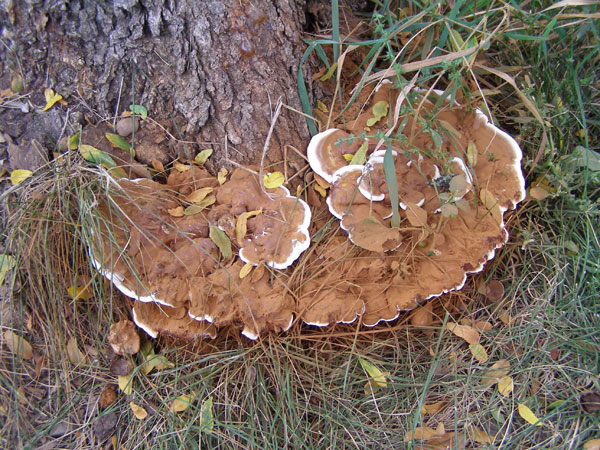Heart disease in trees is caused by fungi invasions. Although there are many species of fungi that cause decay in living trees, most important are those fungi that cause heart decay often called heart rot. These pathogens usually enter the tree as a result of injury Such points of entry may come from broken branches caused by wind, fire, lightning, and even from improper pruning by us humans. Once inside the tree, fungi cause decay. Interestingly, heart rot fungi do not invade the living wood of healthy trees.
Detecting heart rot can be difficult. Since this type of decay takes place internally, it can remain out of sight for many years. Usually, in the latter
stages of heart rot, mushrooms grow on the trunk or branch. This is one of the first visible signs that a fungal pathogen resides within the tree. Unfortunately, as decay progresses, the heartwood is destroyed; and the integrity of the tree’s strength becomes a serious issue.
These external mushrooms are the fruiting bodies of the fungi. They are generally called conks or bracket fungi. These visible conks produces spores. Spores become wind-borne, microscopic, seed-like structures. The wind carries spores to other susceptible trees thus perpetuating the life cycle of conks. These fungi appear bracket-like, attached to the tree and varying greatly in size, color and texture. Note: The visible presence of conks
calls for investigation.
Eliminating or minimizing heart rot is accomplished by keeping one’s tree healthy. When pruning branches, make cuts just outside the branch collar so proper mending can take place. Shape trees at an early age, so major branch removal creates small wounds.
Remove broken branch stubs immediately following storm damage. Have suspected heart rot trees checked by an arborist to determine if sufficient live wood is present for structural safety. Check trees every few years to be certain new growth is maintaining sound structure.
I am certainly not a doomsday advocate, but I do know that large tree trunks and main branches revealing numerous conks are certain indications that little sound wood remains to support the tree.
After all, one doesn’t want heart disease, more commonly called heart rot, in trees to cause the homeowner heartache when his or her tree comes tumbling down damaging, or possibly destroying, his or her home.
Information source: University of Nebraska









